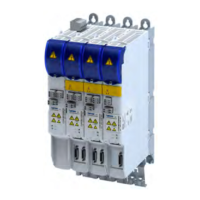Funconal sa
fety
General informaon and basics
The funconal safety describes the necessary measures that need to be taken by means of
electrical or electronic equipment to prevent or eliminate dangers due to malfuncons.
Protecve devices prevent any human access to danger areas during normal operaon.
However, persons may have to be in the danger areas in certain operang modes. The
machine operator is protected by internal drive and control measures in these operang
modes.
Integrated safety
The integrated safety technology fulls the control and drive condions for implemenng the
protecve funcons. The expenses for planning and installaon decrease. Integrated safety
equipment increases machine funconality and availability. The integrated safety system can
be used for the protecon of persons working on machines in accordance with the Machinery
Direcve.
The moon funcons connue to be executed by the inverter. The integrated safety system
monitors the safe compliance with the limit values and provides the safe inputs and outputs.
If monitored limit values are exceeded, the integrated safety system in the inverter reacts with
safety funcons according to EN 61800‑5‑2.
Standards
Safety regulaons are conrmed by laws and other governmental guidelines and measures
and the prevailing opinion among experts, e.g. by technical regulaons.
The regulaons and rules to be applied must be observed in accordance with the applicaon.
Risk assessment
This documentaon can only accentuate the need for a risk assessment. The user of the
integrated safety system must read up on standards and the legal situaon.
Before a machine can be put into circulaon, the manufacturer of the machine has to conduct
a risk assessment according to the 2006/42/EC: Machinery Direcve [UKCA: S.I. 2008/1597 -
The Supply of Machinery (Safety) Regulaons 2008] to determine the hazards associated with
the use of the machine.
The Machinery Direcve refers to three basic principles for the highest possible level of safety:
•
Hazard eliminaon / minimisaon by the construcon itself.
•
Taking the protecve measures required against hazards that cannot be removed.
•
Exisng residual hazards must be documented and the user must be informed of them.
Detailed informaon on the risk assessment is provided in the DIN EN ISO 12100:2013‑08:
Safety of machinery − General principles for design − Risk assessment and risk reducon . The
result of the risk assessment determines the category for safety-related control systems
according to EN ISO 13849‑1. Safety-oriented parts of the machine control must be compliant.
Mission me
The mission me of the used components must be complied with.
In case of a defect or when the mission me of a component has expired, the complete
component must be replaced. Connued operaon is not permied!
The mission me f
or the safety funcons cannot be reset by a special proof test.
The specied mission me starts at the date of manufacture.
Mission me4Technical data ^ 154
Funconal sa
fety
General informaon and basics
109

